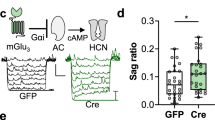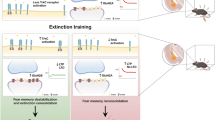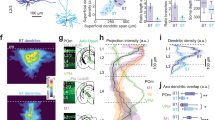Abstract
Various subtypes of metabotropic glutamate receptors (mGluRs) have been implicated in fear extinction, but mGluR2/3 subtype has not been tested. Here, we found that microinjection of an mGluR2/3 antagonist, LY341495, into the lateral amygdala (LA), but not into the adjacent central amygdala (CeA), impaired extinction retention without affecting within-session extinction. In contrast, we failed to detect any significant changes in motility and anxiety during a period when extinction training or retention was performed after LY341495 injection, suggesting that the effect of LY341495 is specific to conditioned responses. Subsequently, on the basis of a previous finding that a long-term potentiation of presynaptic efficacy at cortical input synapses onto the lateral amygdala (C-LA synapses) supports conditioned fear, we tested the hypothesis that activation of mGluR2/3 leads to fear extinction via a long-term weakening of presynaptic functions at C-LA synapses. Fear extinction produced a decrease in C-LA synaptic efficacy, whereas LY341495 infusion into the LA blocked this extinction-induced C-LA efficacy decrease without altering synaptic efficacy at other LA synapses. Furthermore, extinction enhanced paired pulse ratio (PPR) of EPSCs, which inversely correlates with presynaptic release probability, whereas LY341495 infusion into the LA attenuated the extinction-induced increase in PPR, suggesting the presence of mGluR2/3-dependent presynaptic changes after extinction. Consistently, extinction occluded a presynaptic form of depression at C-LA synapses, whereas the LY341495 infusion into the LA rescued this occlusion. Together, our findings suggest that mGluR2/3 is required for extinction retention and that the mGluR2/3 action is mediated by the long-term weakening of release probability at C-LA synapses.
Similar content being viewed by others
Log in or create a free account to read this content
Gain free access to this article, as well as selected content from this journal and more on nature.com
or
References
Aujla H, Martin-Fardon R, Weiss F (2008). Rats with extended access to cocaine exhibit increased stress reactivity and sensitivity to the anxiolytic-like effects of the mGluR 2/3 agonist LY379268 during abstinence. Neuropsychopharmacology 33: 1818–1826.
Bouton ME, Kenney FA, Rosengard C (1990). State-dependent fear extinction with two benzodiazepine tranquilizers. Behav Neurosci 104: 44–55.
Ceolin L, Kantamneni S, Barker GR, Hanna L, Murray L, Warburton EC et al (2011). Study of novel selective mGlu2 agonist in the temporo-ammonic input to CA1 neurons reveals reduced mGlu2 receptor expression in a Wistar substrain with an anxiety-like phenotype. J Neurosci 31: 6721–6731.
Chi H, Jang JK, Kim JH, Vezina P (2006). Blockade of group II metabotropic glutamate receptors in the nucleus accumbens produces hyperlocomotion in rats previously exposed to amphetamine. Neuropharmacology 51: 986–992.
Cho K, Kemp N, Noel J, Aggleton JP, Brown MW, Bashir ZI (2000). A new form of long-term depression in the perirhinal cortex. Nat Neurosci 3: 150–156.
Conn PJ, Lindsley CW, Jones CK (2009). Activation of metabotropic glutamate receptors as a novel approach for the treatment of schizophrenia. Trends Pharmacol Sci 30: 25–31.
Dalton GL, Wang YT, Floresco SB, Phillips AG (2008). Disruption of AMPA receptor endocytosis impairs the extinction, but not acquisition of learned fear. Neuropsychopharmacology 33: 2416–2426.
Davis M, Myers KM, Chhatwal J, Ressler KJ (2006). Pharmacological treatments that facilitate extinction of fear: relevance to psychotherapy. NeuroRx 3: 82–96.
Ehrlich I, Humeau Y, Grenier F, Ciocchi S, Herry C, Luthi A (2009). Amygdala inhibitory circuits and the control of fear memory. Neuron 62: 757–771.
Fendt M, Schmid S, Thakker DR, Jacobson LH, Yamamoto R, Mitsukawa K et al (2008). mGluR7 facilitates extinction of aversive memories and controls amygdala plasticity. Mol Psychiatry 13: 970–979.
Fontanez-Nuin DE, Santini E, Quirk GJ, Porter JT (2011). Memory for fear extinction requires mGluR5-mediated activation of infralimbic neurons. Cereb Cortex 21: 727–735.
Ge Y, Dong Z, Bagot RC, Howland JG, Phillips AG, Wong TP et al (2010). Hippocampal long-term depression is required for the consolidation of spatial memory. Proc Natl Acad Sci USA 107: 16697–16702.
Griffiths S, Scott H, Glover C, Bienemann A, Ghorbel MT, Uney J et al (2008). Expression of long-term depression underlies visual recognition memory. Neuron 58: 186–194.
Helton DR, Tizzano JP, Monn JA, Schoepp DD, Kallman MJ (1998). Anxiolytic and side-effect profile of LY354740: a potent, highly selective, orally active agonist for group II metabotropic glutamate receptors. J Pharmacol Exp Ther 284: 651–660.
Herry C, Ciocchi S, Senn V, Demmou L, Muller C, Luthi A (2008). Switching on and off fear by distinct neuronal circuits. Nature 454: 600–606.
Hong I, Song B, Lee S, Kim J, Kim J, Choi S (2009). Extinction of cued fear memory involves a distinct form of depotentiation at cortical input synapses onto the lateral amygdala. Eur J Neurosci 30: 2089–2099.
Ito M (1986). Long-term depression as a memory process in the cerebellum. Neurosci Res 3: 531–539.
Kim J, Lee S, Park H, Song B, Hong I, Geum D et al (2007a). Blockade of amygdala metabotropic glutamate receptor subtype 1 impairs fear extinction. Biochem Biophys Res Commun 355: 188–193.
Kim J, Lee S, Park K, Hong I, Song B, Son G et al (2007b). Amygdala depotentiation and fear extinction. Proc Natl Acad Sci USA 104: 20955–20960.
Kim J, Song B, Hong I, Kim J, Lee J, Park S et al (2010). Reactivation of fear memory renders consolidated amygdala synapses labile. J Neurosci 30: 9631–9640.
Lebron K, Milad MR, Quirk GJ (2004). Delayed recall of fear extinction in rats with lesions of ventral medial prefrontal cortex. Learn Mem 11: 544–548.
Likhtik E, Popa D, Apergis-Schoute J, Fidacaro GA, Pare D (2008). Amygdala intercalated neurons are required for expression of fear extinction. Nature 454: 642–645.
Lin CH, Lee CC, Huang YC, Wang SJ, Gean PW (2005). Activation of group II metabotropic glutamate receptors induces depotentiation in amygdala slices and reduces fear-potentiated startle in rats. Learn Mem 12: 130–137.
Linden AM, Bergeron M, Schoepp DD. (2005). Comparison of c-Fos induction in the brain by the mGlu2/3 receptor antagonist LY341495 and agonist LY354740: evidence for widespread endogenous tone at brain mGlu2/3 receptors in vivo. Neuropharmacology 49: 120–134.
Lodge D, Tidball P, Mercier MS, Lucas SJ, Hanna L, Ceolin L et al (2013). Antagonists reversibly reverse chemical LTD induced by group I, group II and group III metabotropic glutamate receptors. Neuropharmacology 74: 135–146.
Lucas SJ, Bortolotto ZA, Collingridge GL, Lodge D. (2013). Selective activation of either mGlu2 or mGlu3 receptors can induce LTD in the amygdala. Neuropharmacology 66: 196–201.
Mao SC, Chang CH, Wu CC, Orejarena MJ, Manzoni OJ, Gean PW. (2013). Inhibition of spontaneous recovery of fear by mGluR5 after prolonged extinction training. PLoS One 8: e59580.
Maren S (1999). Neurotoxic basolateral amygdala lesions impair learning and memory but not the performance of conditional fear in rats. J Neurosci 19: 8696–8703.
Maren S, Quirk GJ (2004). Neuronal signaling of fear memory. Nat Rev Neurosci 5: 844–852.
Milad MR, Quirk GJ (2002). Neurons in medial prefrontal cortex signal memory for fear extinction. Nature 420: 70–74.
Monn JA, Valli MJ, Massey SM, Wright RA, Salhoff CR, Johnson BG et al (1997). Design, synthesis, and pharmacological characterization of (+)-2-aminobicyclo[3.1.0]hexane-2,6-dicarboxylic acid (LY354740): a potent, selective, and orally active group 2 metabotropic glutamate receptor agonist possessing anticonvulsant and anxiolytic properties. J Med Chem 40: 528–537.
Myers KM, Davis M (2002). Behavioral and neural analysis of extinction. Neuron 36: 567–584.
Myers KM, Carlezon WA Jr., Davis M (2011). Glutamate receptors in extinction and extinction-based therapies for psychiatric illness. Neuropsychopharmacology 36: 274–293.
Pare D, Duvarci S (2012). Amygdala microcircuits mediating fear expression and extinction. Curr Opin Neurobiol 22: 717–723.
Quirk GJ, Armony JL, LeDoux JE (1997). Fear conditioning enhances different temporal components of tone-evoked spike trains in auditory cortex and lateral amygdala. Neuron 19: 613–624.
Rogan MT, Staubli UV, LeDoux JE (1997). Fear conditioning induces associative long-term potentiation in the amygdala. Nature 390: 604–607.
Royer S, Pare D (2002). Bidirectional synaptic plasticity in intercalated amygdala neurons and the extinction of conditioned fear responses. Neuroscience 115: 455–462.
Sah P, Lopez De Armentia M (2003). Excitatory synaptic transmission in the lateral and central amygdala. Ann N Y Acad Sci 985: 67–77.
Sakagami K, Yasuhara A, Chaki S, Yoshikawa R, Kawakita Y, Saito A et al (2008). Synthesis, in vitro pharmacology, and pharmacokinetic profiles of 2-[1-amino-1-carboxy-2-(9H-xanthen-9-yl)-ethyl]-1-fluorocyclopropanecarboxylic acid and its 6-heptyl ester, a potent mGluR2 antagonist. Bioorg Med Chem 16: 4359–4366.
Sanacora G, Zarate CA, Krystal JH, Manji HK (2008). Targeting the glutamatergic system to develop novel, improved therapeutics for mood disorders. Nat Rev Drug Discov 7: 426–437.
Schroeder BW, Shinnick-Gallagher P (2005). Fear learning induces persistent facilitation of amygdala synaptic transmission. Eur J Neurosci 22: 1775–1783.
Sepulveda-Orengo MT, Lopez AV, Soler-Cedeno O, Porter JT (2013). Fear extinction induces mGluR5-mediated synaptic and intrinsic plasticity in infralimbic neurons. J Neurosci 33: 7184–7193.
Sethna F, Wang H. (2014). Pharmacological enhancement of mGluR5 facilitates contextual fear memory extinction. Learn Mem 21: 647–650.
Swanson CJ, Bures M, Johnson MP, Linden AM, Monn JA, Schoepp DD (2005). Metabotropic glutamate receptors as novel targets for anxiety and stress disorders. Nat Rev Drug Discov 4: 131–144.
Toth I, Dietz M, Peterlik D, Huber SE, Fendt M, Neumann ID et al (2012). Pharmacological interference with metabotropic glutamate receptor subtype 7 but not subtype 5 differentially affects within- and between-session extinction of Pavlovian conditioned fear. Neuropharmacology 62: 1619–1626.
Tsvetkov E, Carlezon WA, Benes FM, Kandel ER, Bolshakov VY (2002). Fear conditioning occludes LTP-induced presynaptic enhancement of synaptic transmission in the cortical pathway to the lateral amygdala. Neuron 34: 289–300.
Walker DL, Rattiner LM, Davis M. (2002). Group II metabotropic glutamate receptors within the amygdala regulate fear as assessed with potentiated startle in rats. Behav Neurosci 116: 1075–1083.
Zucker RS (1989). Short-term synaptic plasticity. Annu Rev Neurosci 12: 13–31.
Author information
Authors and Affiliations
Corresponding authors
Rights and permissions
About this article
Cite this article
Kim, J., An, B., Kim, J. et al. mGluR2/3 in the Lateral Amygdala is Required for Fear Extinction: Cortical Input Synapses onto the Lateral Amygdala as a Target Site of the mGluR2/3 Action. Neuropsychopharmacol 40, 2916–2928 (2015). https://doi.org/10.1038/npp.2015.145
Received:
Revised:
Accepted:
Published:
Issue date:
DOI: https://doi.org/10.1038/npp.2015.145
This article is cited by
-
Neurochemical and molecular mechanisms underlying the retrieval-extinction effect
Psychopharmacology (2019)
-
Mechanisms of fear learning and extinction: synaptic plasticity–fear memory connection
Psychopharmacology (2019)
-
Increased amygdalar metabotropic glutamate receptor 7 mRNA in a genetic mouse model of impaired fear extinction
Psychopharmacology (2019)



